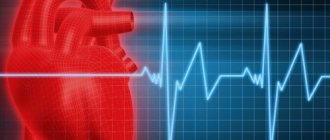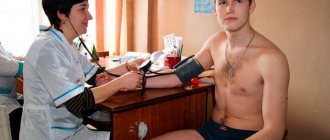- home
- Articles
- Schedule of illnesses
- Can people with heart arrhythmia be drafted into the army?
»
»
»
Updated: September 18, 2021
Free hotline for conscripts and their parents
8
Since diseases of the cardiovascular system are among the group of diseases that especially often serve as grounds for exemption or deferment from military service, the question of whether people with cardiac arrhythmia are taken into the army 2021, for the conscript is among the most actively discussed. However, it is impossible to give a specific answer to this question without taking into account the type, symptoms and causes of this disease, as well as the factors accompanying it.
The army and cardiac arrhythmia
Representing a disease of the cardiovascular system, arrhythmia manifests itself in the acceleration or deceleration of the heart rate and in the disturbance of heart rhythm.
Cardiologists distinguish the following types of cardiac arrhythmia:
- atrial fibrillation, characterized by asynchronous activity of the muscle fibers of the atria, leading to their fluttering in the form of “flickering”;
- sinus, in which the sinus node produces impulses of various frequencies that provoke cardiac arrhythmias;
- sinus tachycardia, manifested in rapid heartbeat, gradually increasing in the range from 90 to 160 beats per minute, followed by a gradual decrease in heart rate to normal values;
- sinus bradycardia, in which the heart rate slows to 60 beats per minute;
- extrasystole, characterized by extraordinary contractions of the heart muscle, provoking cardiac arrhythmias.
- paroxysmal tachycardia, which differs from sinus tachycardia by a sudden increase in heart rate and an equally sudden cessation of heart rate growth.
IMPORTANT! Cardiac pathologies, which in civilian life worsen the quality of life of a young man of military age, can become deadly under conditions of increased physical activity and poor nutrition in the army.
That is why military medical commissions of military registration and enlistment offices pay the closest attention to conducting correct diagnostics when examining conscripts who have complaints of heart problems.
In cases where the arrhythmia observed in a conscript is not caused by serious pathologies and cannot lead to functional disorders in cardiac activity, a young man of conscription age is legally recruited to serve in the army.
Need help getting out of the army?
Call us at 8 (800) 550-25-66 or leave a request and we will answer any questions about the army and obtaining a military ID.
Request a call
Atrial fibrillation and ventricular arrhythmias
In addition to sinus, there are other types of disease that are clearly incompatible with the army, which are prescribed in Article 44 of the “Schedule of Diseases.” After studying the medical record and research results, the doctors who are part of the military medical commission decide whether to take the guy with the detected rhythm disorder into the army or leave him in civilian life.
Young people with serious diagnoses are not called up for military service:
- atrial fibrillation and arrhythmia;
- ventricular extrasystoles in a pronounced form.
Constantly occurring attacks, regular disturbances in cardiac activity, requiring drug treatment, after which relapses occur, will become the basis for enlisting in the reserve or declaring the guy unfit for the army.
The letter “B” affixed to a military ID will mean that in peacetime the young man should not be afraid of receiving summonses. The letter “D” exempts the young man from conscription for life.
The category that determines the future of a particular citizen is assigned according to the list of “Schedule of Diseases”.
Read more about what military fitness categories mean here.
What types of arrhythmias are not accepted into the army?
Sinus and other types of heart rhythm disturbances, based on serious pathologies that adversely affect the health of conscripts and require systematic monitoring by a doctor during the constant treatment of the patient, give doctors legal grounds to exempt such young people from conscription.
But for this, the military medical commission should correctly diagnose such patients using diagnostic tools. For example, in clause 9 of the RF PP No. 565 dated 07/04/2013, as amended on 06/01/2020, it is stated that disturbances in the rhythm and electrical conductivity of the heart are assessed based on ECG analysis at rest.
Article 42 of the Schedule of Diseases defines the fitness categories on the basis of which a conscript can be released from military service due to pathological changes in his cardiovascular system.
Young people of military age will be exempt from the army if they have:
- paroxysmal and atrial fibrillation;
- pronounced ventricular extrasystoles;
- persistent disturbances of heart rhythm and conduction, requiring antiarrhythmic therapy and constant use of appropriate medications;
- mitral valve prolapse;
- cardiac ischemia;
- heart failure;
- heart defect.
What diseases does it manifest itself in?
So, arrhythmia itself never occurs. It is important to establish the disease against which it develops. It is the underlying illness that determines whether a conscript will be accepted into the army or not. The conscript will receive a “white” ticket if, after the examination, the following diagnoses are confirmed:
- Rheumatic fever (Sokolsky-Buyo disease) in combination with heart failure. With this disease, muscle tissue becomes inflamed, which reduces their contractile functions, and blood circulation is impaired. As a result, frequent and prolonged attacks of arrhythmia occur, during which the patient requires medical supervision.
- Acute heart failure with severe arrhythmia.
- Dysfunction of the cardiac conduction system in severe form.
- Acquired or congenital heart defects.
- Incomplete closure of the mitral valve - prolapse.
- Cardiosclerosis is an extremely dangerous pathological process in which the muscle tissue of the heart is replaced by connective tissue.
- Cardiac ischemia in an advanced stage.
- Arterial hypertension in the third stage.
Any of the listed pathologies is the basis for assigning a category “D” (“White Sheet”) to a young person.
Extensive physical exertion and exposure to difficult living and climatic conditions, psycho-emotional stress can provoke an exacerbation, attack and a sharp deterioration in health
Are they calling for sinus arrhythmia in 2021?
Being the most common cardiac pathology among conscripts, this type of cardiac arrhythmia does not make sinus arrhythmia and the army incompatible concepts. Even with this officially established and documented diagnosis, the conscript will most likely not be exempt from military service in 2021.
The basis for this is the fact that most often this deviation is observed in young people leading a sedentary lifestyle. Without proper physical activity, the heart muscle weakens and its rhythm increases. Military service eliminates this deficiency and, accordingly, benefits the young man’s health.
REFERENCE. Such a diagnosis can lead to exemption from military service only if there are serious complications in the body caused specifically by arrhythmia, or if it is detected against the background of more dangerous cardiac pathologies.
General information and classification
The heart constantly changes the rhythm of its contractions. In normal condition, it beats at a frequency of 60-80 beats per minute. Physical or psychological stress speeds up its work - this is an absolutely normal reaction of the body. In a healthy person, the heart beats in a coordinated and stable rhythm, which is regulated by the nervous and endocrine systems. Rhythm disturbances are caused by excessive consumption of alcohol or coffee, smoking, and taking medications.
Pain or feeling of pressure in the chest is one of the characteristic signs of arrhythmia
It is important to understand that rhythm disturbance in itself is not considered a disease; arrhythmias are a manifestation of certain pathologies, most of which can lead to serious consequences. The most common causes of this pathology are:
- ischemic disease (IHD);
- cardiomyopathy;
- heart attacks;
- atherosclerosis;
- asthenia and vegetative-vascular dystonia (VSD);
- myocarditis;
- mitral valve prolapse;
- congenital or acquired premature excitation of the cardiac ventricles (VPV syndrome);
- arterial hypertension;
- excessive weight;
- thyroid dysfunction.
Depending on the location, there are three types of arrhythmia:
- sinus;
- ventricular;
- atrial.
The heart has its own pacemaker - the sinus node. Disturbances in its functioning lead to sinus arrhythmia of the heart. This form of pathology is the most common. In this case, the sequence of phases in the contraction is preserved, but the intervals between them change. The degree of this arrhythmia can be severe or moderate.
According to the nature of arrhythmia disorders, there are:
- Tachycardia. Rapid heartbeat, with a pulse rate of more than 80 beats per minute while maintaining a normal rhythm. If such a condition occurs in a person in a calm state, then we can talk about a potentially dangerous violation;
- Bradycardia. This is a decrease in heart rate. Bradycardia may be a consequence of pathological processes or, conversely, indicate that the heart is trained. Slow heart rate is a characteristic phenomenon among professional athletes;
- Paroxysmal disorders. Sudden attacks of rapid increase in heart rate, which can reach up to 200 beats per minute. A very dangerous condition that can lead to fainting and cardiac arrest. The patient needs urgent medical attention during an attack;
- Extrasystole. One of the most common types of arrhythmia, which occurs when the heart or one of its departments contracts untimely. For example, supraventricular tachycardia is premature contraction of the atrium. Extrasystolic arrhythmia also occurs in healthy people after severe stress, smoking, or a heavy dose of coffee or alcohol. At the same time, extrasystole can be a manifestation of dangerous changes in the myocardium. For example, it develops in chronic heart failure or ischemic heart disease;
- Atrial fibrillation. Pathology occurs due to rhythm disturbances and an increase in the amount of atrial contraction. They begin to “flicker” – that is, they stop working in an organized and synchronous manner. This type of arrhythmia is dangerous and can lead to cardiomyopathy, stroke and sudden cardiac arrest. 15% of cerebral hemorrhages occur in patients with atrial fibrillation.
The moderate form of the disorder can hardly even be called a pathology - it often occurs in older people and adolescents during puberty. Severe sinus arrhythmia, as a rule, is a consequence of the disease and requires consultation with a doctor.
Clinical manifestations of arrhythmia are different and diverse. In the early stages, this pathology, as a rule, is not expressed at all. Typical symptoms of rhythm disturbances are:
- weakness and dizziness;
- difficulty breathing;
- chest pain and pressure;
- rapid pulse or “fading” of the heart;
- frequent headaches;
- tremor of the limbs;
- anxiety or panic attacks;
- loss of consciousness.
The problem is that the symptoms described above are similar to those of other, less dangerous diseases. Often they are not paid attention to at all, attributing them to stress, fatigue or physical exertion.
Different types of rhythm disturbances on the electrocardiogram
The main method for diagnosing heart rhythm disturbances is electrocardiography. In addition to the usual examination, patients are prescribed an ECG during exercise, as well as daily monitoring of the electrical activity of the heart. An electrocardiogram can show the regularity of heart contractions, extrasystoles, myocardial damage and conduction disorders. Also, when diagnosing arrhythmia, a blood test for hormone levels, ultrasound and echography of the heart are prescribed, sometimes the patient needs to have an MRI of the brain, radiography and ultrasound of the kidneys.
To treat arrhythmia, medications, physiotherapy and surgical methods are used. Pacemakers are very effective in correcting heart rhythm. These are small devices that stimulate the heart muscle through special electrodes and make it work correctly.
People suffering from such a pathology have to radically change their lifestyle: give up bad habits, coffee, excessive exercise, sleep normally, and avoid stress. One thing to remember: the sooner dysfunction is detected and treatment is started, the greater the chance of a favorable outcome.
How to get exemption for heart disease
Various types of cardiac pathologies require an equally large number of examinations and medical consultations when a young man undergoes a draft medical examination.
When diagnosing cardiac arrhythmia, it is first necessary to identify the presence of other, more complex diseases of the cardiovascular system. To do this, the conscript receives a referral for examination by a cardiologist. In this case, the doctor is guided by the provisions of articles 42-48 of the Schedule of Diseases dedicated to heart diseases.
After a detailed examination, the cardiologist makes a final diagnosis, which is the basis for members of the medical commission of the military registration and enlistment office when assigning a fitness category to a conscript.
IMPORTANT! The basis for exemption from military service can only be officially documented results of diagnostic studies of pathologies in the condition of the conscript’s cardiovascular system.
Is it possible to slant based on arrhythmia?
It's no secret that most young people are not eager to serve in the military. The most popular and safest way to avoid conscription is to feign some serious illness. Very often, conscripts are punished for heart disease.
Arrhythmia is definitely not the best diagnosis for simulation. It never starts just like that, but is a consequence or symptom of another disease, usually quite serious. Those with common sinus arrhythmia are recruited into the army. Only the most dangerous forms of rhythm disturbances, which do not arise suddenly and out of nowhere, are guaranteed exemption from conscription. If a young man does not have serious evidence of his diagnosis, then most likely they will not listen to him at all. But even in the presence of a serious pathology, a “military officer” is not issued immediately, but only after several checks and examinations. They are usually carried out in a hospital.
Installation of a pacemaker is considered one of the most effective treatments for severe heart rhythm disorders.
To confirm the diagnosis, the conscript will have to undergo several types of ECG (regular, under load, daily monitoring) and undergo a lot of tests. It’s definitely not possible to deceive complex equipment. And it’s not at all easy to deceive doctors who are well aware of all the tricks of the malingerers. You can also add that attempting to evade military service is a crime punishable by law.
Diagnosis confirmation
The main research methods that a conscript must undergo include:
- Electrocardiogram (in a calm and active state).
- Ultrasound examination of the heart.
- Orthostatic pulse test.
- Daily ECG monitoring.
It is worth noting that the commission’s decision is also influenced by the nature of sinus arrhythmia, which can cause serious consequences for the body. The most dangerous types of arrhythmia: ventricular extrasystole, mitral valve prolapse syndrome, supraventricular tachycardia, weak sinus node.
What troops can you serve in?
If a conscript with a mild form of arrhythmia is declared fit without restrictions, assignment to the troops will be made randomly.
If limited fitness has been assigned, next to the main category a number must be indicated indicating the group of troops to which this category applies. Categories “B” are as follows: “B-1”, “B-2”, “B-3” and “B-4”.
Arrhythmia almost always falls into the “B-3” category. This is the most extensive category of fitness, because it includes most conscription diseases without significant impairment of functions. With fitness category “B-3” they are called to:
- drivers of infantry fighting vehicles and armored personnel carriers;
- missile launch installations;
- internal troops of the Ministry of Internal Affairs;
- pipeline troops and other chemical work;
- control and operation of anti-aircraft missile systems.
Eligibility categories for sinus arrhythmia
Before being assigned to a military unit for service, a conscript undergoes a medical examination, on the basis of which one or another fitness category is determined:
- "A". Fully suitable for military service. Can serve in all its units, including the landing force and the navy;
- "B". A conscript is recognized as limitedly fit for military service and can serve in certain troops;
- "IN". Sent to the reserves and, in the event of general mobilization, called up for military training;
- "G". Provides a temporary deferment from service due to the need for therapeutic measures with subsequent recommission;
- "D". The conscript is completely unsuitable for military service.
Symptoms of arrhythmia
The clinical picture of arrhythmias can be very different and depends on the form of the disorder. Let's characterize the most common ones.
Arrhythmias associated with impaired automaticity
sinus node.
Here, options are possible with a change in the rate of generation of electrical signals and heart contractions towards an increase ( sinus tachycardia
) or decrease (
sinus bradycardia
), as well as unequal time intervals between systoles (
sinus arrhythmia
). A normal heart rate for a healthy adult is considered to be between 60 and 90 beats per minute. A tachyarrhythmia greater than 90 beats/min will be felt as a rapid heartbeat. With bradycardia less than 40 beats/min, weakness, dizziness are a concern, fainting is possible due to a decrease in cerebral perfusion, and with a frequency of more than 40 beats/min, it is usually asymptomatic, like sinus arrhythmia.
Ectopic contractions manifest themselves as a feeling of freezing, shuddering, “tumbling,” and interruptions in the functioning of the heart. They speak of ectopia if the point of birth of the electrical signal is not the sinus node. If the contraction from the ectopic impulse occurs prematurely, before the completion of the stage of cardiac relaxation, they speak of extrasystole
. Additional foci of excitation can be present at different levels and, accordingly, generate supraventricular (atrial, atrioventricular) and ventricular extrasystoles. Often untimely contractions alternate with normal sinus ones and can be single, paired or grouped.
Three or more systoles in a row, uniform in their non-sinus origin, are considered an ectopic rhythm
(atrial, atrioventricular, idioventricular). When an unnatural source of excitation is highly active and, suppressing the sinus one, becomes a pacemaker, paroxysmal tachycardia occurs (heart rate more than 140 beats/min). The patient notices intense heartbeat.
Flutter
- rhythmic contraction of the atria/ventricles at a very high frequency (200-400 per minute).
Fibrillation
(350-700 beats/min) is a random, low-productive contraction of the myocardium, otherwise called fibrillation. Atrial flutter and fibrillation are relatively favorable. Due to the inhibitory, filtering effect of the AV node, only a portion of the electrical excitations are carried out to the ventricles, due to which they are reduced at a frequency an order of magnitude lower (usually no more than 160/min). The state of health suffers in a manner similar to tachycardia and extrasystole; shortness of breath, dizziness, and heart pain may occur.
Ventricular flutter and fibrillation are life-threatening conditions and, in the absence of emergency measures (defibrillation), quickly lead to the death of the patient.
Heart block
- weakening or complete cessation of electrical conductivity of a certain section of the conductive system. It can appear and disappear without treatment (then it is called transient), or be permanent. The symptoms here depend on the location, the degree of blockade, in mild forms they are absent, in moderate and severe forms they correspond to rhythm irregularity and bradyarrhythmia.
In general, the absence of symptoms of arrhythmia is a fairly common occurrence, and the detection of rhythm disturbances occurs by chance during an examination for another reason.
Diagnosis of arrhythmia.
If you suspect an arrhythmia, you need to consult a specialist for examination and diagnosis to confirm or refute the diagnosis. A cardiologist examines and treats arrhythmias. Arrhythmia is a dangerous disease, so you should never self-medicate. Any medications can only be prescribed by a doctor. The drug itself, if taken incorrectly, can cause arrhythmia attacks.
At the initial appointment with a cardiologist, the doctor will ask questions about symptoms and the frequency of their manifestations, listen to the heart and measure the pulse. It is important to provide your entire medical history to your doctor. To find out the causes of arrhythmia, you will need to undergo basic tests:
- blood chemistry;
- blood test for clotting.
For further research and to exclude more serious pathologies, you will undergo an instrumental diagnostic study.







